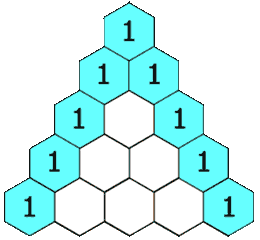-
Notifications
You must be signed in to change notification settings - Fork 266
Pascal's Triangle II
- 🔗 Leetcode Link: Pascal's Triangle II
- 💡 Problem Difficulty: Easy
- ⏰ Time to complete: 15 mins
- 🛠️ Topics: Recursion, DP, Bottom-Up
- 🗒️ Similar Questions: Pascal's Triangle, Fibonacci Number, Climbing Stairs, Min Cost Climbing Stairs, Best Time to Buy and Sell Stock
Understand what the interviewer is asking for by using test cases and questions about the problem.
- Established a set (2-3) of test cases to verify their own solution later.
- Established a set (1-2) of edge cases to verify their solution handles complexities.
- Have fully understood the problem and have no clarifying questions.
- Have you verified any Time/Space Constraints for this problem?
Be sure that you clarify the input and output parameters of the problem:
- What is the max row of the pascal triangle do we generate?
- 33
- What are the minimum row-index?
- The minimum row-index is 0 and it's the row with 1.
- What is the time and space complexity for this problem?
-
O(n^2)time andO(n)space will do.
-
Run through a set of example cases:
Input: rowIndex = 3
Output: [1,3,3,1]Input: rowIndex = 1
Output: [1,1]
EDGE CASE
Input: rowIndex = 0
Output: [1]Match what this problem looks like to known categories of problems, e.g. Linked List or Dynamic Programming, and strategies or patterns in those categories.
- 2D Array Top-Left -> Bottom-Right, Bottom-Up DP Technique
- We are not working with a 2D Array, but we can use the Bottom-Up DP Technique to build up our answers from previous calculation.
- Knapsack-Type Approach
- This does not fit the knapsack-type approach.
- Cache previous results, generally
- Yes, we can use the Top-Down DP Technique and recursion to build our answers from previous recursive calls, but that would be a round about way of solving this algorithm.
Plan the solution with appropriate visualizations and pseudocode.
General Idea: Bottom-Up DP Technique, we will build up our answer. We will find the next row of the pascal triangle from the previous row. We can add zeros to the beginning and end of row to help with calculation of next row. We will reuse the previous row to save memory
1. Set the basecase, [1] in result
2. Generate number of rows as requested
a. Add zeros to the beginning and end of previous row for calculation
b. For each item in row, set it to be itself plus the next number.
c. Remove the last zero, because we only need one new number
d. Set the new row to result
3. Return the results- This problem may looks quite simple at the first glance, however we are using the fundamentals of dynamic programming to record past results to be reused in future calculation. Here we reuse the previous row to save memory.
Implement the code to solve the algorithm.
class Solution:
def getRow(self, rowIndex: int) -> List[int]:
# Set the basecase, [1] in results
result = [1]
# Generate number of rows as requested
for i in range(rowIndex):
# Add zeros to the beginning and end of previous row for calculation
row = [0] + result + [0]
# For each item in row, set it to be itself plus the next number
for j in range(len(row) - 1):
row[j] = row[j] + row[j + 1]
# Remove the last zero, because we only need one new number
row.pop()
# Set the new row to result
result = row
# Return the results
return resultclass Solution {
public List<Integer> getRow(int k) {
Integer[] arr = new Integer[k + 1];
Arrays.fill(arr, 0);
// Set the basecase, [1] in results
arr[0] = 1;
// Generate number of rows as requested
for (int i = 1; i <= k; i++)
// For each item in row, set it to be itself plus the previous number
for (int j = i; j > 0; j--)
arr[j] = arr[j] + arr[j - 1];
return Arrays.asList(arr);
}
}Review the code by running specific example(s) and recording values (watchlist) of your code's variables along the way.
- Trace through your code with an input to check for the expected output
- Catch possible edge cases and off-by-one errors
Evaluate the performance of your algorithm and state any strong/weak or future potential work.
Assume N represents the number of rows
-
Time Complexity:
O(N^2), because we need to build up each row, and the number of items in each rows averagesN/2items. -
Space Complexity:
O(N), because we need to hold the row withNitems in memory.
